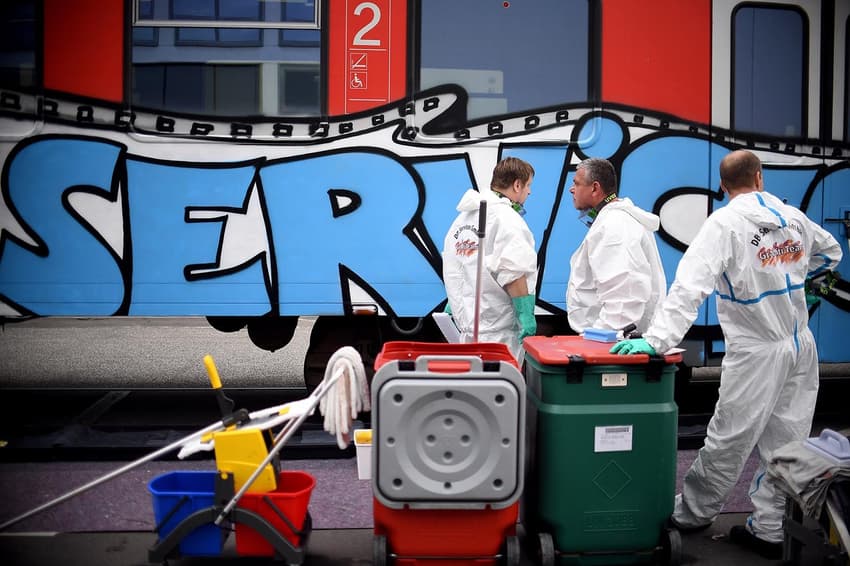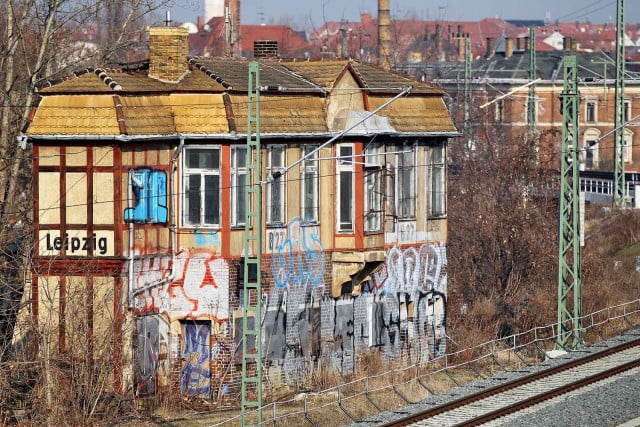Train graffiti: How Germany is tackling its €38 million problem

For residents and visitors to Germany, graffiti on trains and at stations is nothing surprising. But new figures obtained by The Local illustrate the scale of the problem.
Police say that graffiti is most commonly a problem in larger cities, although there are incidents all over Germany.
The most problematic cities for authorities are Berlin, Hamburg, Halle and Leipzig, along with metropolitan areas in Baden-Württemberg and North Rhine-Westphalia.
There are disagreements as to the trend of the problem. While police indicate that the figures are gradually decreasing, reports from Deutsche Bahn show that the problem is on the rise.
READ: 'Child-free' Hamburg cafe hit with graffiti attack
READ: 'Nazi' sprayed on food charity which refused to take new migrant clients
READ: How Berlin activists are turning Nazi hate graffiti into art
As reported by DPA, the impact of graffiti isn’t purely aesthetic damage. Costs and train delays are a major issue as a result of graffiti.
Coordinated campaigns and graffiti tourism
Graffiti on the train lines and at stations has a variety of messages, from political messaging to support for football teams.
Those behind the graffiti are also a diverse group, from bored teenagers to organized gangs.
Police told the Berliner Morgenpost that ‘graffiti tourism’ was increasingly a problem in the city, with budding graffiti sprayers coming from other parts of Germany - and indeed other countries - to make their mark in the Hauptstadt.
Police cited the recent detention of a 16-year-old Australian tourist in relation to property damage offences as an example of the growing problem.
While Berlin's street art culture is a big tourist magnet, the police said they consider any form of graffiti on trains or stations to be property damage — no matter its artistic merit.
IN PICTURES: Berlin's best street art
Other than tourists, organized local gangs are also frequently responsible.
In Berlin, an organized team of graffiti sprayers chose the day of a recent train strike to launch a coordinated assault on the city’s public transport.
In total, 140 wagons were sprayed - with the paint covering an estimated 2,000 square metres. 
Graffiti on a station building in Leipzig. Image: DPA
“Not an increasing problem”
A spokesperson for the Federal Police told The Local that while graffiti was still a significant issue, “graffiti on trains is at the moment not an increasing problem”.
Figures obtained by The Local from the Federal Police show a slight overall decrease in relation to previous years.
While 7,819 cases occurred in 2018 — the majority of which were on S-Bahn trains — there were 8,300 cases in 2017. The 2016 figures were against slightly higher at 8,360.
The spokesperson told The Local “it would be impossible to determine the (graffiti) situation on lines run by regional operators as trains often run through several states”.
An increase on Inter City Express trains - and at stations
However figures provided by Deutsche Bahn indicated a trend in the opposite direction. In 2018 graffiti increased by eight percent, with 20,100 cases recorded.
Unlike the figures from the Federal Police, the Deutsche Bahn figures take into account all incidents of graffiti both at train stations and on long-distance trains.

'Team for graffiti-free train stations' - A Deutsche Bahn campaign against graffiti. Image: DPA
Deutsche Bahn estimated the damage to be in the vicinity of €38 million. While the company spent €13 million repairing the damage caused by graffiti across 2018, much of it is not removed.
Berlin’s BVG, responsible for the city’s public transport, estimate a yearly spend of €10 million on graffiti removal in Berlin alone.
Delays and higher costs for passengers
Officials have pointed out that the effects of the graffiti are not purely aesthetic.
The board production DB Regio, Oliver Terhaag, told DPA: "Unfortunately, the effects of graffiti are also felt by our passengers. The affected cars are taken from the fleet, so then shorter trains are on the way, which are sometimes extra full,” he said.
“At stops it could cause delays in getting in and out, which has a negative impact on punctuality.”
The steps taken to prevent and clean up graffiti also result in more expensive costs imposed on passengers.
p.p1 {margin: 0.0px 0.0px 0.0px 0.0px; font: 12.0px Helvetica}
p.p2 {margin: 0.0px 0.0px 0.0px 0.0px; font: 12.0px Helvetica; min-height: 14.0px}
p.p3 {margin: 0.0px 0.0px 0.0px 0.0px; line-height: 14.0px; font: 12.0px Times; color: #042eee; -webkit-text-stroke: #042eee}
p.p4 {margin: 0.0px 0.0px 0.0px 0.0px; line-height: 14.0px; font: 12.0px Times; color: #042eee}
span.s1 {text-decoration: underline ; font-kerning: none}
span.s2 {text-decoration: underline ; font-kerning: none; -webkit-text-stroke: 0px #000000}
Comments
See Also
Police say that graffiti is most commonly a problem in larger cities, although there are incidents all over Germany.
The most problematic cities for authorities are Berlin, Hamburg, Halle and Leipzig, along with metropolitan areas in Baden-Württemberg and North Rhine-Westphalia.
There are disagreements as to the trend of the problem. While police indicate that the figures are gradually decreasing, reports from Deutsche Bahn show that the problem is on the rise.
READ: 'Child-free' Hamburg cafe hit with graffiti attack
READ: 'Nazi' sprayed on food charity which refused to take new migrant clients
READ: How Berlin activists are turning Nazi hate graffiti into art
As reported by DPA, the impact of graffiti isn’t purely aesthetic damage. Costs and train delays are a major issue as a result of graffiti.
Coordinated campaigns and graffiti tourism
Graffiti on the train lines and at stations has a variety of messages, from political messaging to support for football teams.
Those behind the graffiti are also a diverse group, from bored teenagers to organized gangs.
Police told the Berliner Morgenpost that ‘graffiti tourism’ was increasingly a problem in the city, with budding graffiti sprayers coming from other parts of Germany - and indeed other countries - to make their mark in the Hauptstadt.
Police cited the recent detention of a 16-year-old Australian tourist in relation to property damage offences as an example of the growing problem.
While Berlin's street art culture is a big tourist magnet, the police said they consider any form of graffiti on trains or stations to be property damage — no matter its artistic merit.
IN PICTURES: Berlin's best street art
Other than tourists, organized local gangs are also frequently responsible.
In Berlin, an organized team of graffiti sprayers chose the day of a recent train strike to launch a coordinated assault on the city’s public transport.
In total, 140 wagons were sprayed - with the paint covering an estimated 2,000 square metres. 
Graffiti on a station building in Leipzig. Image: DPA
“Not an increasing problem”
A spokesperson for the Federal Police told The Local that while graffiti was still a significant issue, “graffiti on trains is at the moment not an increasing problem”.
Figures obtained by The Local from the Federal Police show a slight overall decrease in relation to previous years.
While 7,819 cases occurred in 2018 — the majority of which were on S-Bahn trains — there were 8,300 cases in 2017. The 2016 figures were against slightly higher at 8,360.
The spokesperson told The Local “it would be impossible to determine the (graffiti) situation on lines run by regional operators as trains often run through several states”.
An increase on Inter City Express trains - and at stations
However figures provided by Deutsche Bahn indicated a trend in the opposite direction. In 2018 graffiti increased by eight percent, with 20,100 cases recorded.
Unlike the figures from the Federal Police, the Deutsche Bahn figures take into account all incidents of graffiti both at train stations and on long-distance trains.

'Team for graffiti-free train stations' - A Deutsche Bahn campaign against graffiti. Image: DPA
Deutsche Bahn estimated the damage to be in the vicinity of €38 million. While the company spent €13 million repairing the damage caused by graffiti across 2018, much of it is not removed.
Berlin’s BVG, responsible for the city’s public transport, estimate a yearly spend of €10 million on graffiti removal in Berlin alone.
Delays and higher costs for passengers
Officials have pointed out that the effects of the graffiti are not purely aesthetic.
The board production DB Regio, Oliver Terhaag, told DPA: "Unfortunately, the effects of graffiti are also felt by our passengers. The affected cars are taken from the fleet, so then shorter trains are on the way, which are sometimes extra full,” he said.
“At stops it could cause delays in getting in and out, which has a negative impact on punctuality.”
The steps taken to prevent and clean up graffiti also result in more expensive costs imposed on passengers.
p.p1 {margin: 0.0px 0.0px 0.0px 0.0px; font: 12.0px Helvetica} p.p2 {margin: 0.0px 0.0px 0.0px 0.0px; font: 12.0px Helvetica; min-height: 14.0px} p.p3 {margin: 0.0px 0.0px 0.0px 0.0px; line-height: 14.0px; font: 12.0px Times; color: #042eee; -webkit-text-stroke: #042eee} p.p4 {margin: 0.0px 0.0px 0.0px 0.0px; line-height: 14.0px; font: 12.0px Times; color: #042eee} span.s1 {text-decoration: underline ; font-kerning: none} span.s2 {text-decoration: underline ; font-kerning: none; -webkit-text-stroke: 0px #000000}
Join the conversation in our comments section below. Share your own views and experience and if you have a question or suggestion for our journalists then email us at [email protected].
Please keep comments civil, constructive and on topic – and make sure to read our terms of use before getting involved.
Please log in here to leave a comment.